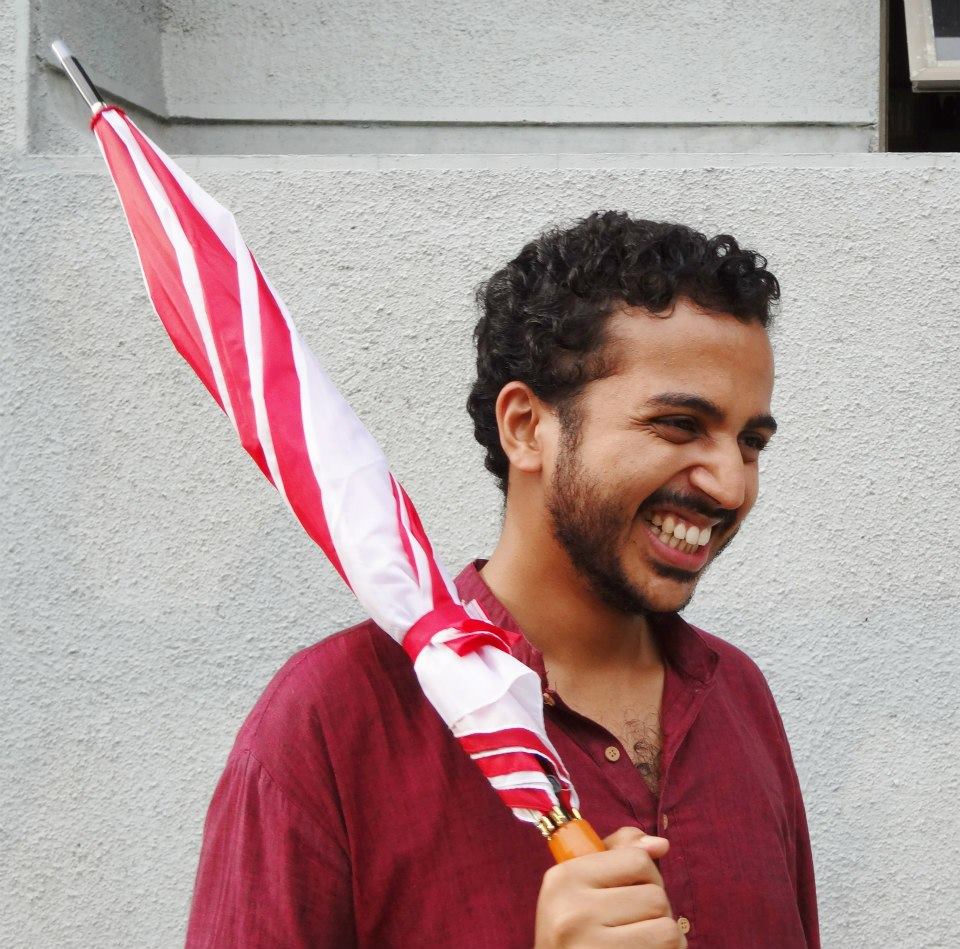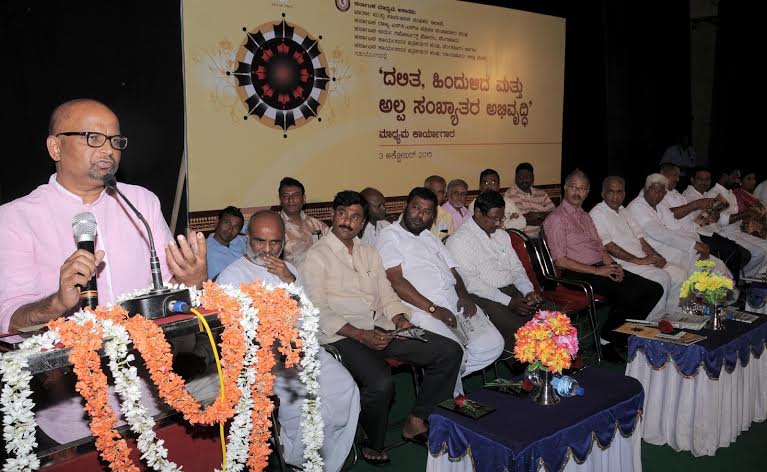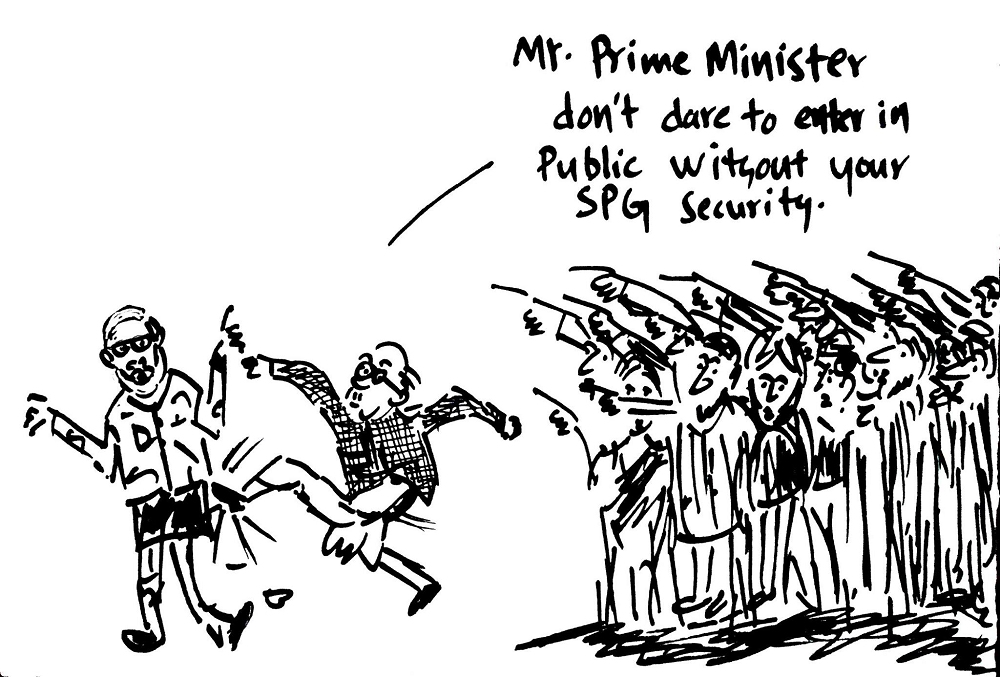Nidhin Shobhana
‘Every Image embodies a way of seeing’ – John Berger.
 He enters the giant classroom in his crisp white short kurta, he walks with an ease which inspires pensive and fearful silence; he is fair-skinned, well-fed and tall, and he speaks clearly with authority.
He enters the giant classroom in his crisp white short kurta, he walks with an ease which inspires pensive and fearful silence; he is fair-skinned, well-fed and tall, and he speaks clearly with authority.
One of the most powerful images of our classroom has been the ‘authoritarian male teacher’. Authority male figures, who are most often heterosexual and upper-caste contribute to, and even shape our ways of seeing, and thereby our ways of knowing. Let it be our homes, public gardens, streets, classrooms, conferences or workplaces. He seems to be Omnipresent. Almost like God.
I do not intend to study this figure in a variety of sites. My site of enquiry is the classroom and every other allied space in institutions of higher education. Again I do not claim to attempt an in-depth, expansive mapping of diversity. All I aim is to unravel the cultural image of the authoritarian male teacher from my experience as an M.A. student. I would try and answer the question- What does the ‘powerful male teacher’, or more precisely, the ‘powerful caste-male, heterosexual teacher’ symbolize and embody?
This question is important for several reasons, especially, in a context where we find very few visible, documented enquiries on the ‘powerful’. Today, our academy is facing quite a few challenges. These challenges are primarily posed by the protesting social groups. They have been raising fundamental questions on how we know and understand things. They are forcing conversations which were absent a while ago. The ‘traditional’ researcher is being brought under scrutiny. Ideas of merit and articulation are being smashed and recast. My question will contribute to these on-going struggles. This attempt aims at liberating the authority male figure more than anybody else. The allegory of the male teacher authority will surely suit many female teachers as well. I do realize the differences between them. I would need another essay to explain those differences.
Classroom offers a very interesting site to understand the dynamics of our society. One finds several layers of power and hatred in its arrangement. The evident layer of power is that of the teacher and his students (like Man, his wife and his children!). I think the imagery of a temple explains our classroom space.
All eyes, moist in fearful devotion, are directed towards the center, and in this case the teacher’s desk. The teacher is the ‘norm’. Students are seated in their groups. These groups are often homogenous in terms of caste, class, region, language, sexuality and gender. The ‘societal other’ who also embody the ‘classroom other’ seem to congregate almost magically in the same site, beside each other. Very similar to a temple (or even a caste church)! They have an ‘out of sight’ existence. An existence beyond the wall. Their experiential universe in the classroom is also ‘out of sight, out of mind’. And if they are cozily patronized to share harmless, non-threatening experiences they become the ‘exotic other’. However, if they assert themselves independently they become the ‘detested, divisive others’.
The male teacher authority stations himself at the center, like a priest flirting with a Hindu idol. He conducts the class. You can either sit on his lap, rest your head on his tummy or get crushed by his weight. You should accept him as the sole source of excellence and information. His words should precede and follow his words. He is the right mix of jargons and punctuations.
Though the imagery of a temple is helpful it is not sufficient. Things are much more complex. The male teacher authority believes that he exists only in the form of a voice. He thinks that his body is absent or not visible. However, his body along with his voice is often an erotic inspiration for his devotees. His beaming voice apparently negates his surname, thinking that he is beyond all identities. He is thought of as ‘Objective’ and ‘Balanced’ unlike a Dalit teacher or even worse a Dalit feminist teacher. May be, for the upper-caste students who still populate our classrooms he is non-threatening and even a deep sigh of relief. He is seen as the master of the broader, more inclusive narratives. He addresses the world and not a primordial community. He is the king of macro-contexts and the prince of master-narratives. He is their macro man!
As the class gets over, devotees line up for his blessings. The color of the student’s collar really matters when he hand picks his devotees. They research and theorize under his armpit. He guides and defends their (I mean, his) findings. The devotees in-breed and reproduce many more devotees. They continue the legacy. They form such a water-tight caste that conversations with them would be possible only if you volunteer to memorize their prayers and recite them loudly in every gathering. Now, this description may seem mythical. However, we may surely find such groups around us, across ideological spectrums.
There are two things which bother me at this juncture. Firstly, if such academic castes are formed in a university space, or more precisely, in a classroom space, what happens to the ‘classroom other’? Secondly, what do these academic caste formations say about the content and pedagogy of education?
The enthusiastic ‘other’ who wants to write her thesis in Dalit Feminism or, say, ‘Dalits and land rights’ would surely confront a set of questions/suggestions/ orders/ apologies from the authority male teacher figure. For example, ‘Just because you are Dalit, you’ll talk only about caste? Grow up, embrace larger categories’, ‘You know, Dalit feminism is not my expertise, haven’t read anything about it!’, ‘Is there enough material on this topic?’, ‘I think you should approach one of your teachers’. The onus of not finding enough material or not keeping track of developments in the academy or movements is squarely put on the ‘classroom other’. Ultimately, you have a situation where SC/ST students have SC/ST guides.
The changing social composition of our classrooms in the past few decades should be a moment of celebration for all egalitarian struggles. However, the changing composition also poses a potent challenge to obsolete pedagogical tools and content of education. The authority male teachers are not ready to accept the challenge which has been knocking at their doors. They believe in communicating ‘progressive’ ideas in the most authoritative, undemocratic, by default brahmanical mode. This should be viewed as the biggest undoing of our universities. I’ll try to explain this by pointing out at an example closer home.
In Tata Institute of Social Sciences, foundation courses are taught in the convention centre. The convention centre is a huge, glassed structure. Its outer wall has a sanitized depiction of diversity in India. It has a seating capacity of 600. However, last year more than 750 students were taught their foundations in the centre. The stalwarts who have designed the course believe in mass education. So basically, you have a situation where one teacher and many security guards control the performance (anger, joy and pleasure) in the convention centre. This situation is further aided by the weapon called compulsory attendance. The space by itself has a cold air of arrogance and authority which gets further reinforced when you have the authority caste-male heterosexual teacher delivering his dogma with breath-taking charisma. Gender and Caste are accommodated as separate sections. Some teachers do break the convention of the convention centre with their humour and love for dialogue. But they are crippled by both time and space limitations. However, these teachers who break conventions have a marginal existence. Furthermore, students who have always nurtured a romantic picture of the authority male teacher, confuse his arrogance for his intellect. While the existence of female teacher authority gets questioned almost always!
Dissent, democracy, social justice and the gospel of many liberatory ideas are taught in a speech and space which negates these ideas. This is the basic contradiction, of the ‘convention centre model’. The convention centre model is modeled around the authority caste-male heterosexual teacher figure.
The male teacher authority figure shows no sign of self-reflection in any of his long lectures. He makes himself less human, de-contextualized and alien in his narratives. Any humane, contextualized examples and explanations given by Dalit, Adivasi and Feminist teachers would be counted as ‘less scholarly’ and ‘subjective’.
bell hooks writes ‘Openness is the foundation of an insightful dialogue’. There is no openness in the closed convention centre, literally or metaphorically. As an extension, there is no openness in the authority male teacher figure. The cultural image of this figure reflects the dirt of our society in starch white short kurtas. Recognizing and exposing negative histories are important for an insightful dialogue. It’s a need of all times to confront the limitations of one’s training. Transformative ideas can only be communicated through transformative pedagogies. Such methods should question and annihilate the master/slave dichotomy. For this, the authority male teacher figure should stand in front of a mirror, preferably naked, and ask simple questions like ‘Who am I?’
~~~
Nidhin Shobhana works with Krantijyoti Savitribai Phule Women’s Studies Centre, Dyanjyoti Savitribai Phule University, Pune.
Cartoon by Nidhin Shobhana.










